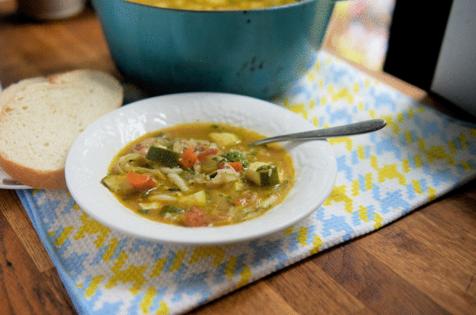Sugarcone cabbage a sweet, fresh take on one of the world's oldest vegetables
Published in Variety Menu
When it comes to leafy green vegetables, cabbage sometimes gets a bad rap because, woof! It can really stink up your kitchen if you don't cook it just right.
The sulfur in the leaves that gives the humble, cruciferous veggie its characteristic pungent taste breaks down during cooking, releasing a strong, rotten egg-like smell that spreads and lingers. It's especially odorous when boiled.
Large heads of cabbage also can crowd out other vegetables in your refrigerator crisper, and, thanks to its high water content, can spoil in just a few days if improperly stored.
That puts the vegetable on the bottom of the grocery list for some home cooks, despite its wide availability, versatility, health benefit and affordability. (Common green cabbage can often cost less than $1 a pound.)
A new variety developed by Row 7 Seed Co. aims to put cabbage higher on your shopping list and just maybe make it a centerpiece at mealtime. Dubbed Sugarcone cabbage, it just made its debut at Whole Foods markets across the U.S.
A trusted staple
Cabbage — which belongs to the plant family of brassicas — has fed people through both good times and bad since antiquity.
One of the world's oldest vegetables, the leafy green is thought to have been cultivated in the Mediterranean around 4,000 years ago. The Romans brought it north to England when Julius Caesar invaded in 55 B.C., and by the Middle Ages, it was a popular food for peasants since it was easy to grow.
First brought to the Americas by French maritime explorer Jacques Cartier in 1541, it became an important staple for early European settlers in the New World because it was both inexpensive and nutritious. By the 18th century, it was a common garden crop and culinary workhorse.
Crunchy when raw and tender and sweet when roasted, cabbage is as good a supporting actor in salads and stir-fries as it is in soups, casseroles, braised dishes and wrapped around a mixture of meat and rice in galumpki.
Sugarcone — which resembles a giant ice cream cone — is bred to naturally contain more sugar. That makes it sweeter than standard, spherical cabbage, and creates thin and delicate lettuce-like leaves that are both juicy and crunchy.
Sugarcone is also a lot smaller (and cuter) than those hefty, cannon ball-sized green cabbages most of us grew up with. Most weigh between 1 and 2 pounds, which makes it easier to store in the fridge and cuts down on waste and leftovers.
Pointed cabbage, which is also known as cone, sweetheart or hispi cabbage, has been around for decades. But it's only been embraced by chefs in the last decade or so as a great-tasting ingredient that shines in a leading role.
"It's been an underground cult following in the food community," says Liz Mahler, chief operating officer for Row 7 Seed Co.
One of its early fans was acclaimed farm-to-table chef Dan Barber, who opened the restaurant Blue Hill at Stone Barns in New York's Hudson Valley in 2004 along with his family.
So when Row 7 — which Barber founded in 2018 with plant breeder Michael Mazourek and seed farmer Matthew Goldfarb — was looking to add to its roster of "democratized" vegetables that thrive both in the kitchen and the field, cone head cabbage seemed like a logical choice.
Already popular in London and other European cities, "it's also making its way into farmers markets in the U.S.," Mahler notes.
Yet there was one caveat when the seed company started its first trials earlier this year at farms in Massachusetts and New York: making it mainstream. After all, Barber is a recognized advocate for the "seed-to-table" movement.
"We wanted to source a variety that wasn't just for white tablecloth restaurants," says Mahler, "but one that home cooks could also enjoy and experience."
A lot of the cabbages grown today have been bred to hold up for transport on trucks, says Mahler, with firm and dense heads and tough outer leaves that protect the inner head during travel. That single-minded focus on durability has led to cabbage losing its flavor.
Sugarcone cabbage, which is both sweet and tender, is "a gentle rebuke to everything we've accepted about what cabbage should be," according to its creators.
"We just saw this potential as something delicious and special and transformative in [the] cabbage space, which is a little sleepy and can use some excitement," says Mahler.
The seeds are sourced from an independent seed company in the Netherlands that leads in cabbage breeding and is known for developing vegetables with flavor and resilience. Regional organic growers include Plainville Farms in Hadley, Mass., Row by Row Farm in Hurley, N.Y., and Spiral Path Farm just north of Carlisle, Pa.
What growers appreciate about Sugarcone cabbage, says East Coast produce manager Larry Tse, is that it's a small cabbage. That makes it easier to harvest, and helps with weed control because it can be planted more densely, "in a sea of cabbage."
That, in turn, helps cut down on labor, though learning how to harvest the cone-shaped heads can initially be challenging.
Sugarcone is also a fast grower — it matures in about 70 days after being planted — which means it can be harvested three or four times a year.
"And it's a fun variety for growers" who are used to round cabbages, says Tse. "They love the shape" as much as the taste.
Launched in mid-September, Sugarcone cabbage is currently available at more than 300 Whole Foods Market stores across California, Texas, the Northeast and the Mid-Atlantic, including in Pittsburgh. Depending on sales, they're hoping to scale it to more retailers in 2026.
At $2.99 a pound, it's a little more expensive than other specialty cabbages like Napa or Savoy (and way more expensive than green cabbage) but the flavor makes it worth it, says Mahler.
"We pay our growers to be able to take a risk on a new crop," she notes, "and we also want to make sure everyone on the team is well compensated."
But at least you get a bang for the buck: Low in calories, salt and sugar, the leafy vegetable is high in fiber and antioxidants, and just one cup contains 85% of your recommended daily value of vitamin K and 54% of the vitamin C.
Thanks to its fine texture, it's also very versatile. You can shave it raw into a salad or slaw; stuff the leaves with rice or meat; or ferment it into sauerkraut or kimchi. But the best way to enjoy it may be to simply roast some with a little butter until the leaves char and caramelize.
In bringing the cabbage to Whole Foods, its creators hope to bring excitement to the market and encourage consumers to try new vegetables.
A lot of what is pushed out to market is about high yield and uniformity, says Tse.
"We're not necessarily looking for those things. We want things that taste good, and we work with our growers every step of the way and support them. That makes these varieties really come alive."
Says Mahler, "We love bringing new, delicious and joyful vegetables into the world."
Sugarcone Cabbage Wedge with Dill Yogurt
PG tested
If you're trying to get someone to try cabbage, this is the dish to start with. It's easy to make and just so incredibly tasty. I may never have enjoyed a vegetable more — after one bite, I ended up eating an entire half cabbage while standing at my sink.
The herbed yogurt is a lovely finishing touch but it's not necessary.
1 head Sugarcone cabbage
3 tablespoons butter
2 garlic cloves, minced
1 sprig thyme
1 sprig rosemary
2 tablespoons mirin
1 teaspoon salt
1/2 teaspoon white pepper
1/2 cup thick Greek yogurt
2 tablespoons fresh chopped dill, plus sprigs for garnish
Preheat oven to 375 degrees.
Cut cabbage in half lengthwise, then trim the rounded sides so each half sits flat.
In large saute pan, melt butter with garlic, thyme, rosemary, mirin, salt and white pepper. Spoon this mixture generously over the cut sides of the cabbage, allowing it to soak in.
If saute pan is oven-safe, transfer it directly to the oven; if not, transfer the cabbage to a sheet pan, cut side up.
Roast for about 1 hour, flipping halfway through and basting with pan juices as it cooks.
For a clean, sliceable wedge with a meatier texture, let the roasted cabbage cool, then press it between parchment-lined sheet pans with a heavy weight on top. Refrigerate for several hours or overnight. To serve, reheat at 375 degrees for 15-20 minutes, until lightly crisped.
Mix the yogurt with chopped dill. Cut the cabage pieces in half, then top each piece with a spoonful of the dill yogurt and a sprig of dill.
Serves 4.
— Row 7 Seed Co.
Vietnamese Chicken Salad with Sweet Lime-Garlic Dressing
PG tested
There's a reason why I so often reach for a Milk Street cookbook when I'm playing around with a new ingredient. The recipes are always straightforward, and delicious.
This recipe, which levels up that grocery store rotisserie chicken that so effortlessly feeds your family on weeknights, is a classic example. It comes together quickly and packs a punch of awesome flavor.
1/3 cup lime juice, plus lime wedges for serving
3 1/2 tablespoons fish sauce
1 1/2 teaspoons white sugar
2 medium cloves garlic, minced
1 small red onion, quartered lengthwise and thinly sliced
3 cups cooked shredded chicken
4 cups shredded cabbage
4 medium carrots, peeled and shredded on the large holes of a box grater (about 2 cups)
3 medium jalapeno peppers, stemmed, halved lengthwise and thinly sliced
1 cup lightly packed fresh basil
1 cup lightly packed fresh cilantro leaves
1 1/2 cup roasted, salted peanuts, roughly chopped
In small bowl, stir together lime juice, fish sauce, sugar and garlic, until the sugar dissolves.
Add onion and let stand for 10 minutes, stirring occasionally.
In large bowl, toss together chicken, cabbage, carrots, jalapenos, basil and cilantro.
Pour on red onion-dressing mixture and toss.
Toss in half the peanuts, then transfer to a serving bowl.
Sprinkle with the remaining peanuts and serve with lime wedges on the side.
Serves 6.
—"Milk Street Shorts: Recipes that Pack a Punch" by Christopher Kimball
Vegetable Minestrone with Pasta
PG tested
This recipe from Lidia Bastianich's latest cookbook, which goes on sale Oct. 13, makes a big pot of soup. But it freezes well.
I omitted the pork butt for a vegetarian version of this hearty soup. I didn't have elbow macaroni on hand so added the pasta from a box of Kraft Macaroni & Cheese, and also took the shortcut of using canned cannelini beans instead of dried. The pesto added at the end really elevates the flavor to the next level.
With a piece of grilled Italian bread, this is a comforting, nourishing meal.
For soup
1/2 cup extra virgin olive oil, divided, plus more as needed
1 medium onion, chopped
2 medium carrots, peeled and chopped
2 stalks celery, chopped
Kosher salt
1/2 teaspoon red pepper flakes, and more as needed
3 garlic cloves, peeled and sliced
1 14.5-ounce can whole San Marzano tomatoes, crushed by hand
2 fresh bay leaves or 3 dried
2 15-ounce cans cannellini beans, rinsed and drained
1 large Idaho potato, peeled and cut into 1/2 -inch dice
4 cups shredded green cabbage
2 small zucchini, trimmed and cut into a 1/2 -inch dice
1 up tubettini or small elbow pasta
For pesto
1 cup loosely packed fresh basil leaves
1/2 cup freshly grated Grana Padano or Parmigiano Reggiano
Heat 1/4 cup of olive oil in a large soup pot or Dutch oven over medium heat. Add onion, carrots and celery, season with 2 teaspoons salt and the peperoncino.
Cook, stirring occasionally, until the vegetables are wilted, about 4 minutes.
Add garlic, let it sizzle for a minute, then add tomatoes and let the liquid simmer for 10 minutes.
Add 5 quarts water and bay leaves, and bring to a rapid simmer. Season with 1 teaspoon salt.
Simmer for an additional 20 minutes to blend the flavors, then add canned beans along with potatoes and cabbage.
Bring soup to a rolling boil, adjust heat to simmering, and cook, partially covered, until liquid has thickened, about 20 minutes. Add zucchini, and cook until it's softened, about 10 minutes. (The soup can be prepared to this point up to 2 days in advance. Cool to room temperature, then chill it completely. Bring to a boil, stirring occasionally, before continuing.)
Stir the pasta into the soup, and cook, stirring occasionally, until it's al dente, about 8 minutes.
While pasta is cooking. combine basil, grated cheese and remaining 1/4 cup olive oil in a mini food processor. Process until you have a coarse pasta, adding a little more oil if necessary. Season to taste with salt.
Taste soup, and season with more salt and red pepper flakes if necessary. Let it rest, off heat, for 5 minutes.
Stir pesto into the soup, and ladle into warm soup bowls.
Makes about 4 quarts.
— adapted from "Lidia's The Art of Pasta" by Lidia Matticchio Bastianich and Tanya Bastianich Manuali (Knopf, $35)
© 2025 the Pittsburgh Post-Gazette. Visit www.post-gazette.com. Distributed by Tribune Content Agency, LLC. ©2025 PG Publishing Co. Visit at post-gazette.com. Distributed by Tribune Content Agency, LLC.










Comments